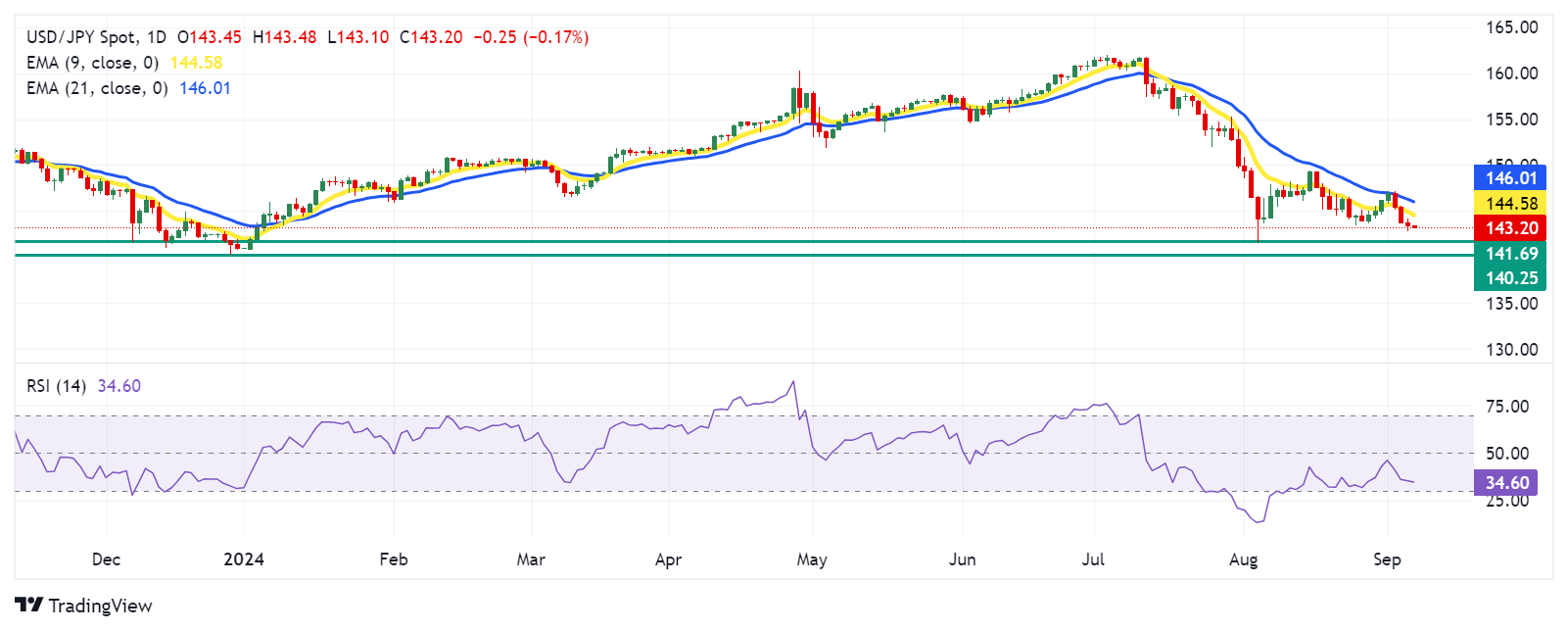- The Japanese Yen appreciated as rising Labor Cash Earnings bolstered the odds of further BoJ rate hikes.
- BoJ’s Takata stated that "if the economy and prices move as expected, we will adjust the policy rate in several stages."
- The US Nonfarm Payrolls report is expected to show 160,000 new jobs in August, up from July’s 114,000.
The Japanese Yen (JPY) continues its winning streak for the fourth successive session as rising real wages in July fuel speculation that the Bank of Japan (BoJ) may introduce another interest rate hike before the end of 2024. Additionally, the USD/JPY pair has encountered headwinds due to a softer US Dollar (USD), driven by dovish comments from Federal Reserve (Fed) officials.
Bank of Japan (BoJ) Board Member Hajime Takata stated on Thursday that "if the economy and prices move in line with our forecast, we will adjust the policy rate in several stages." Takata also mentioned that the domestic economy is recovering moderately, despite some signs of weakness. While stock and FX markets have experienced significant volatility, he noted that the BoJ still sees the achievement of its inflation target within reach.
Traders are likely to await Friday's release of labor market data, including the US Nonfarm Payrolls (NFP), to gather further insights on the potential size of an anticipated rate cut by the Federal Reserve (Fed) this month.
Daily Digest Market Movers: Japanese Yen extends upside due to hawkish mood surrounding the BoJ
- Chicago Fed President Austan Goolsbee said on Friday that the longer-run trend of the labor market and inflation data justify the Fed easing interest-rate policy soon and then steadily over the next year. FXStreet’s FedTracker, which gauges the tone of Fed officials’ speeches on a dovish-to-hawkish scale from 0 to 10 using a custom AI model, rated Goolsbee’s words as neutral with a score of 3.8.
- ADP Employment Change showed on Thursday that private-sector employment increased by 99,000 in August, following July’s increase of 111,000 and below the estimate of 145,000. Meanwhile, the weekly US Initial Jobless Claims rose to 227,000 for the week ending August 30, compared to the previous reading of 232,000 and below the initial consensus of 230,000.
- Japan’s Labor Cash Earnings grew by 3.6% year-on-year, a deceleration from June's 4.5% increase but the highest since January 1997, surpassing market expectations of 3.1%.
- San Francisco Federal Reserve President Mary Daly stated on Wednesday that "the Fed needs to cut the policy rate as inflation is declining and the economy is slowing." Regarding the size of the potential rate cut in September, Daly noted, "We don't know yet." FXStreet’s FedTracker, which gauges the tone of Fed officials’ speeches on a dovish-to-hawkish scale from 0 to 10 using a custom AI model, rated Daly’s words as neutral with a score of 3.6.
- Atlanta Federal Reserve President Raphael Bostic said that the Fed is in a favorable position but added that they must not maintain a restrictive policy stance for too long, per Reuters. FXStreet’s FedTracker, which gauges the tone of Fed officials’ speeches on a dovish-to-hawkish scale from 0 to 10 using a custom AI model, rated Bostic’s words as neutral with a score of 4.6.
- Japan’s Chief Cabinet Secretary Yoshimasa Hayashi stated on Wednesday that he is "closely monitoring domestic and international market developments with a sense of urgency." Hayashi emphasized the importance of conducting fiscal and economic policy management in close coordination with the Bank of Japan (BoJ).
- US JOLTS Job Openings dropped to 7.673 million in July, down from 7.910 million in June, marking the lowest level since January 2021 and falling short of market expectations of 8.10 million.
- Jibun Bank Services PMI data on Wednesday. The index was revised to 53.7 in August from an initial estimate of 54.0. Although this marks the seventh consecutive month of expansion in the service sector, the latest figure remains unchanged from July.
Technical Analysis: USD/JPY falls toward 143.00, followed by seven-month lows
USD/JPY trades around 143.30 on Friday. A daily chart review shows that the nine-day Exponential Moving Average (EMA) remains below the 21-day EMA, indicating a persistent bearish trend. Additionally, the 14-day Relative Strength Index (RSI) is near the 30 level, reinforcing the bearish momentum but also hinting at the possibility of an upward correction soon.
In terms of support, the USD/JPY pair is falling toward the seven-month low of 141.69, recorded on August 5. Additional key support appears at 140.25, which is the lowest level since July 2023.
On the upside, the USD/JPY pair might first encounter a barrier at the nine-day EMA around 144.60, followed by the 21-day EMA at 146.02. A break above these EMAs might weaken the bearish sentiment and push the pair toward the psychological level of 150.00.
USD/JPY: Daily Chart
Japanese Yen PRICE Today
The table below shows the percentage change of Japanese Yen (JPY) against listed major currencies today. Japanese Yen was the strongest against the Australian Dollar.
| USD | EUR | GBP | JPY | CAD | AUD | NZD | CHF | |
|---|---|---|---|---|---|---|---|---|
| USD | -0.05% | 0.03% | -0.57% | -0.02% | 0.24% | 0.20% | -0.19% | |
| EUR | 0.05% | 0.09% | -0.52% | 0.01% | 0.29% | 0.23% | -0.15% | |
| GBP | -0.03% | -0.09% | -0.60% | -0.05% | 0.22% | 0.16% | -0.23% | |
| JPY | 0.57% | 0.52% | 0.60% | 0.55% | 0.82% | 0.74% | 0.35% | |
| CAD | 0.02% | -0.01% | 0.05% | -0.55% | 0.26% | 0.22% | -0.18% | |
| AUD | -0.24% | -0.29% | -0.22% | -0.82% | -0.26% | -0.06% | -0.45% | |
| NZD | -0.20% | -0.23% | -0.16% | -0.74% | -0.22% | 0.06% | -0.40% | |
| CHF | 0.19% | 0.15% | 0.23% | -0.35% | 0.18% | 0.45% | 0.40% |
The heat map shows percentage changes of major currencies against each other. The base currency is picked from the left column, while the quote currency is picked from the top row. For example, if you pick the Japanese Yen from the left column and move along the horizontal line to the US Dollar, the percentage change displayed in the box will represent JPY (base)/USD (quote).
Employment FAQs
Labor market conditions are a key element in assessing the health of an economy and thus a key driver for currency valuation. High employment, or low unemployment, has positive implications for consumer spending and economic growth, boosting the value of the local currency. Moreover, a very tight labor market – a situation in which there is a shortage of workers to fill open positions – can also have implications on inflation levels because low labor supply and high demand leads to higher wages.
The pace at which salaries are growing in an economy is key for policymakers. High wage growth means that households have more money to spend, usually leading to price increases in consumer goods. In contrast to more volatile sources of inflation such as energy prices, wage growth is seen as a key component of underlying and persisting inflation as salary increases are unlikely to be undone. Central banks around the world pay close attention to wage growth data when deciding on monetary policy.
The weight that each central bank assigns to labor market conditions depends on its objectives. Some central banks explicitly have mandates related to the labor market beyond controlling inflation levels. The US Federal Reserve (Fed), for example, has the dual mandate of promoting maximum employment and stable prices. Meanwhile, the European Central Bank’s (ECB) sole mandate is to keep inflation under control. Still, and despite whatever mandates they have, labor market conditions are an important factor for policymakers given their significance as a gauge of the health of the economy and their direct relationship to inflation.
Information on these pages contains forward-looking statements that involve risks and uncertainties. Markets and instruments profiled on this page are for informational purposes only and should not in any way come across as a recommendation to buy or sell in these assets. You should do your own thorough research before making any investment decisions. FXStreet does not in any way guarantee that this information is free from mistakes, errors, or material misstatements. It also does not guarantee that this information is of a timely nature. Investing in Open Markets involves a great deal of risk, including the loss of all or a portion of your investment, as well as emotional distress. All risks, losses and costs associated with investing, including total loss of principal, are your responsibility. The views and opinions expressed in this article are those of the authors and do not necessarily reflect the official policy or position of FXStreet nor its advertisers. The author will not be held responsible for information that is found at the end of links posted on this page.
If not otherwise explicitly mentioned in the body of the article, at the time of writing, the author has no position in any stock mentioned in this article and no business relationship with any company mentioned. The author has not received compensation for writing this article, other than from FXStreet.
FXStreet and the author do not provide personalized recommendations. The author makes no representations as to the accuracy, completeness, or suitability of this information. FXStreet and the author will not be liable for any errors, omissions or any losses, injuries or damages arising from this information and its display or use. Errors and omissions excepted.
The author and FXStreet are not registered investment advisors and nothing in this article is intended to be investment advice.
Recommended content
Editors’ Picks

EUR/USD retreats below 1.0800 ahead of US data
EUR/USD loses traction and trades below 1.0800 on Tuesday. The risk-averse market atmosphere ahead of Wednesday's tariff announcements makes it difficult for the pair to hold its ground as the market attention turns to US data releases.

GBP/USD struggles to stabilize above 1.2900
Following a short-lasting uptick in the European session, GBP/USD edges lower and trades slightly below 1.2900 on Tuesday. The US Dollar (USD) holds its ground as investors adopt a cautious stance in anticipation of data releases and Wednesday's tariff decisions.

Gold pulls away from record highs, holds comfortably above $3,100
Gold corrects lower but manages to hold comfortably above $3,100 after touching a new record-high near $3,150 earlier in the day. Falling US Treasury bond yields help XAU/USD limit its losses as investors refrain from taking large positions ahead of US tariff announcements.

JOLTS job openings set to decline modestly in February
The Job Openings and Labor Turnover Survey (JOLTS) will be released on Tuesday by the United States Bureau of Labor Statistics. Markets expect job openings to decline to 7.63 million on the last business day of February.

Is the US economy headed for a recession?
Leading economists say a recession is more likely than originally expected. With new tariffs set to be launched on April 2, investors and economists are growing more concerned about an economic slowdown or recession.

The Best brokers to trade EUR/USD
SPONSORED Discover the top brokers for trading EUR/USD in 2025. Our list features brokers with competitive spreads, fast execution, and powerful platforms. Whether you're a beginner or an expert, find the right partner to navigate the dynamic Forex market.


